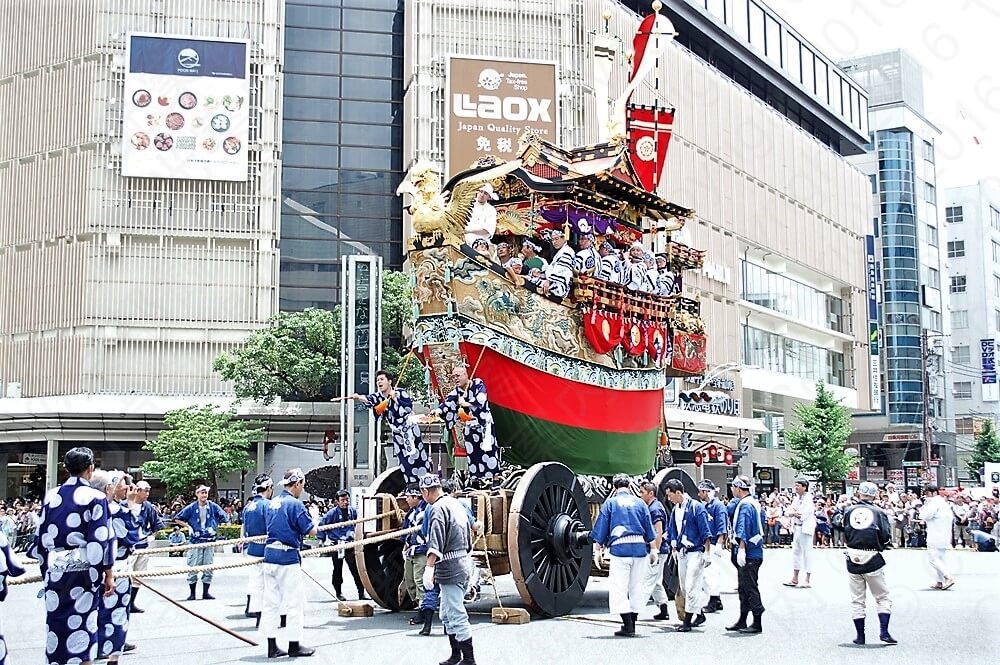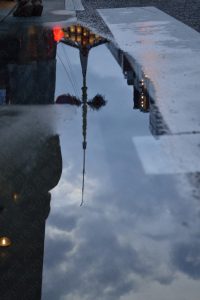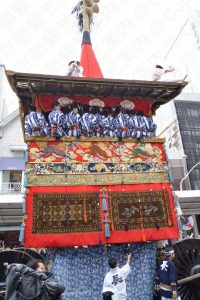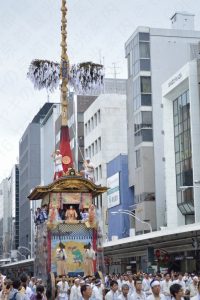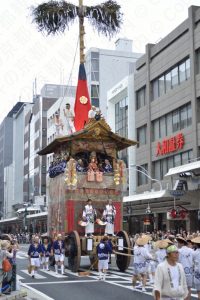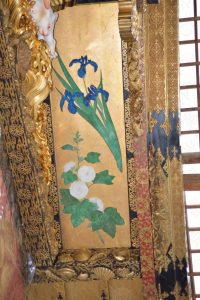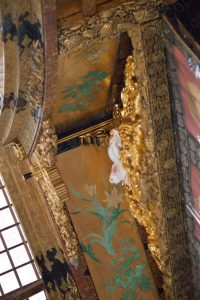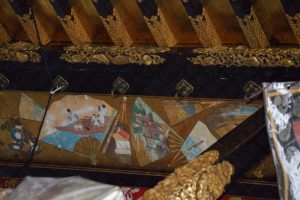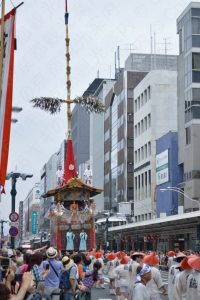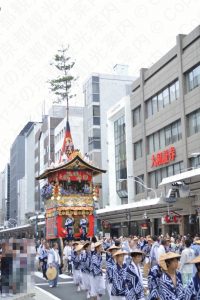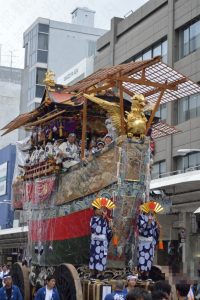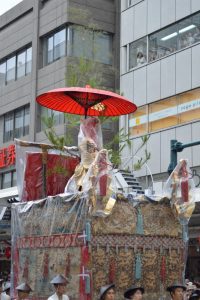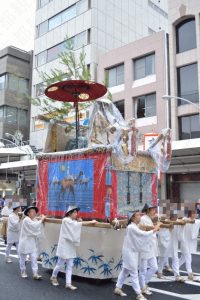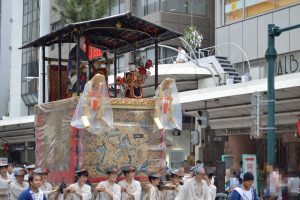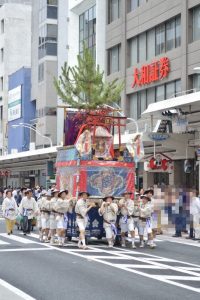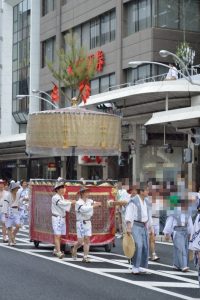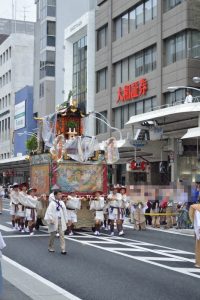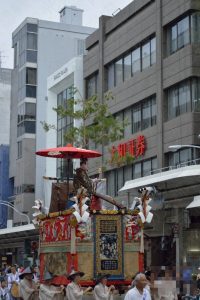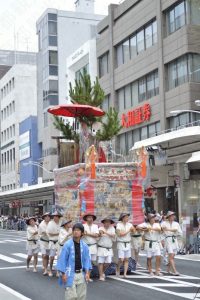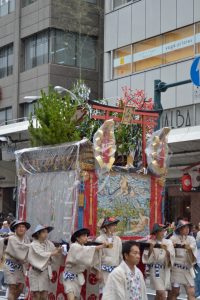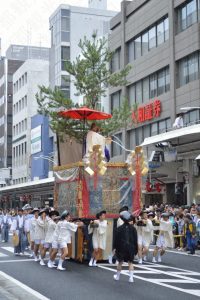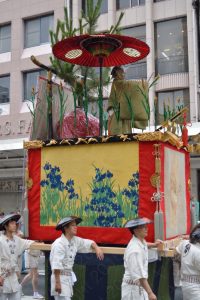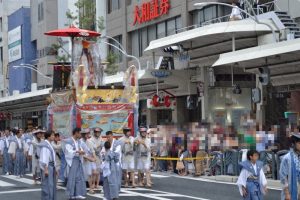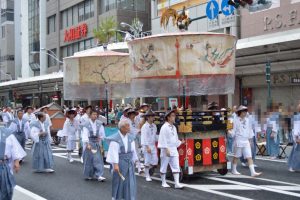Yamahoko in Sakimatsuri
Naginata Hoko
Naginata hoko is the most popular and famous Hoko in Gion matsuri festival. It is only Yamahoko which has Ekichigo on it.
Nginata is a traditional Japanese sword invented in Heian period. Naginata hoko has long naginata on the roof.
Kanko Hoko
Kanko Hoko was named after an old Chinese story about Lord Mengchang. When he was on the run, he was in front of Kankoku Kan Gate on the border. The gate usually opened in morning. He shouted, “Cock-a-doodle-doo!” and the gate was opened and he escaped narrowly.
Tsuki Hoko
Tsuki Hoko is the most beautifull Yamahoko with paintings and ornaments. Tea party were sometimes held on Tsukihoko in Edo period.
Niwatori Hoko
Niwatori Hoko was named after an ancient Chinese story: In the rein of Yao, anyone dissatisfied was to ring a drum but no one in his rein was in need to that and hen make nest in it. Niwatori Hoko stands for peace.
Hoka Hoko
Hoka is a half-monk and half-commedian. Hoka Hoko enshrines him. It has Chigo figurine who dances Chigomai like Ikichigo on Naginata Hoko.
Iwato Yama
Iwato Yama is on Japanese mythology. I tells what we are. It has a figurine of Amaterasu Ohomikami. Amaterasu is believed that a female Deity but the figurine describes the Deity is a male.
Fune Hoko
Fune Hoko is also on Japanese mythology. It is a ship for Empress Jingu. She was on the way to a war. When she was pregnant, she was in a battle field. She put a cold stone on her belly to make the birth of his son late. After the war ended, she came back to Japan and gave birth to Emperor Ohjin. Ofunahoko is believed that it gives ladies easy delivery. Fune Hoko
Yamabushi Yama
Yamabushi Yama enshrines Yamabushi, monks who trains themselves in the mountain to gain super-natural power.
Moso Yama
The figurine on Moso Yama has a bamboo shoot. It tells us an ancient Chinese story: Moso found a bamboo shoot in snow. He bring it to his mother because it is her favorite food. When she ate it, she recovered from illness. So, the figurine smiles. Billy Holiday sings, “When you’re smiling, the whole world smiles with you.”
Taishi Yama
Taishi yama tells us the story of the foundation of Rokkakudo temple.
Kakkyo Yama
Kakkyo Yama is base on an ancient Chinese story. Kakkyo suffered in poverty. He couldn’t manage his family and decided to left his children in the mountain. On the way to the mountain, he found a pan full of treasury.
Hosho Yama
Hosho was a samurai. His love asked him to bring Ume flower in the Imperial Palace. He managed it and escaped narrowly. Hosho Yama is very popular for love-seekers.
Abura Tenjin Yama
Abura Tenjin Yama enshrines a court noble who make a district it belongs to revived after the huge fire.
Shijo Kasa Hoko
It is one of 2 Kasa hoko. It is a simple form of Yamahoko.
Toro Yama
Toro Yama has a figurine of mantis. To our surprise, it moves.
Kakuga Yama
Hakuga Yama is named after an ancient Chinese story. Hakuga, the virtuoso of Koto breaks his Koto in the face the death of his closest friend.
Tokusa Yama
Tokusa Yama tells us a sad story of Noh. An old man cut grasses in sadness because his son was kidnapped. The only Hoko makes us sad in the parade.
Arare Tenjin Yama
When Kyoto was on a huge fire, snow pellets put it down. With them, a small figurine of Tenjin Deity fell from the sky. Arare Tenjin Yama enshrines it.
Hakurakuten Yama
It shows us a convesation of Bai Juyi and a monk. Bai asked him what the Buddhist teaching means. The monk said “To do good thing and not to do bad thing.” Bai replyed, “Even a 3 years old kid knows that.” The monk said, “But even a 80 years old person fails to do that.”
Ashikara Yama
It shows us a Noh story. An old man lives separated his wife.In the end, he meets her again and leads a happy life.
Urade Yama
Urade Yama is based on Japanese mythology. Empress Jingu fished a sweet fish and it make her a conviction of the triumph.
Ayagasa Hoko
Ayagasa hoko consists of 2 hoko in the same forms of Kasa Hoko.

